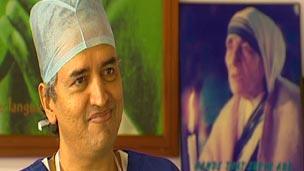'Production line' heart surgery
- Published
Inside India's 'production line' heart hospital
The chest of a thirteen-year-old boy Uday Kumar has been sliced open and a team of doctors are operating on his heart.
"This is for patients who have a single ventricle," says the senior surgeon Colin John, "with reduced pulmonary blood flow."
Similar complex procedures are taking place in a line of operating theatres stretching down the corridor.
This is cardiac surgery on the production line, in an extraordinary hospital in India.
The Narayana Hrudayalaya in Bangalore is the largest heart surgery hospital in the world. It has 1,000 beds, and last year it carried out a staggering 6,000 operations, half of them on children.
By contrast Great Ormond Street in London did less than 600.

Dr Shetty would like to see his care model adopted by the UK
"We are all products of the National Health Service in the UK, and what we learnt over there we have implemented in perhaps a slightly different manner," says Dr Devi Shetty, India's most famous heart surgeon, and the driving force behind the hospital.
"We believe that the only way is to build large hospitals - 100 or 200 beds are not going to be the solution for the current world health problem. We need to build large hospitals where hundreds of operations are carried out every day."
And here in Bangalore, the theory appears to work. Despite the huge volume of operations, mortality rates are comparable with or better than those in Britain and the US, and costs are much lower.
Lessons from abroad
Little wonder that Dr Shetty and his hospital have been attracting attention from around the world. One recent visit was from a British delegation travelling to India with the Prime Minister David Cameron.
They were keen to see what lessons could be learnt for health care back home.
"What we're trying to do in the UK because of our budget problem is to get more for less," explained Britain's Business Secretary Vince Cable to a group of senior hospital executives.
"Not having inferior health because there's less money, but actually getting more out of the system for less resource. And you've shown us a model here by which we can do this."
Alongside the heart hospital are two neighbouring facilities - one dedicated exclusively to orthopaedics, and one to cancer treatment. They call it a health city. Vince Cable described the visit as quite inspirational.
"I just found it overwhelming. It combines what we always see in a good health system, which is humane humanitarian behaviour, with sound economics."
In a series of wards upstairs, heart patients are recovering from surgery and waiting to go home. The average cost of surgery here is a fraction of what it costs in the West, and patients come to Bangalore from all over the world.
The very poorest are never turned away either. Under a subsidised scheme, CS Manju Nath, a local man, had complex heart surgery here for next to nothing.
"I couldn't work because of illness," he says, sitting up in bed. "I used to get tired so easily. But I just didn't have the money for surgery. It's only because of this hospital that I could have an operation."
In other words, some patients are treated for a significant financial loss to the hospital. But the volume of operations is so large, that it still makes an overall profit.
Now Dr Shetty is expanding his business interests. He's building a new hospital in the Cayman Islands - a joint venture with the government there - designed to appeal to patients in nearby Florida who may not have full insurance cover.
And he says he's interested in creating a 'health city' in Britain as well, where he predicts costs could plummet.
"When one building and all the specialists in that building do only one procedure - that is taking care of the heart - obviously the results get better," he argues. "And the costs go down significantly.
"In the US a heart surgery costs perhaps 20 or 30 times what it costs here. We are able to do a complex heart surgery for $1,800 (£1,140), and we want to bring it down to $800."
He has been called the 'Henry Ford' of heart surgery. It is mass production, which appears to be a resounding success.
A simple business plan, but potentially quite revolutionary.
Could this be a vision of the future for health care, in Britain and around the world?